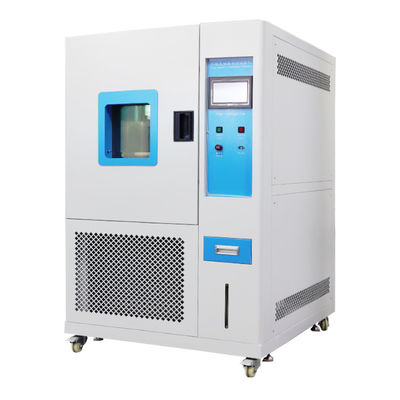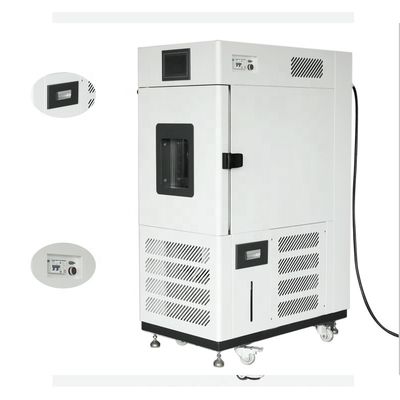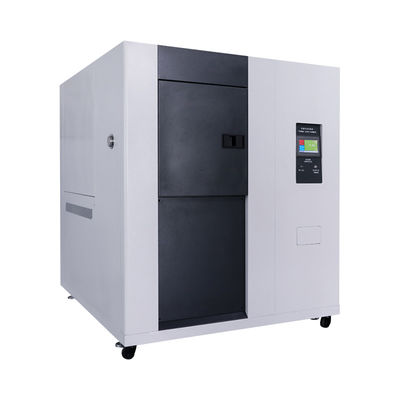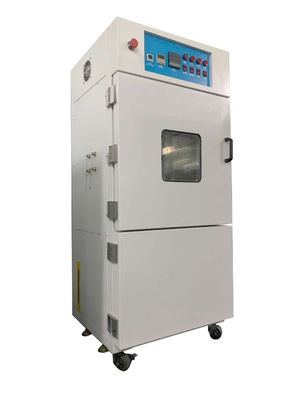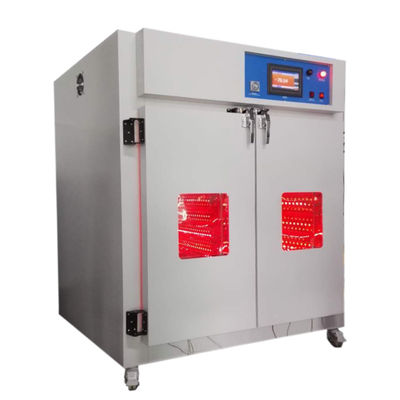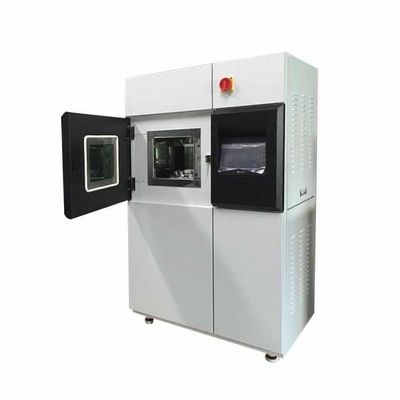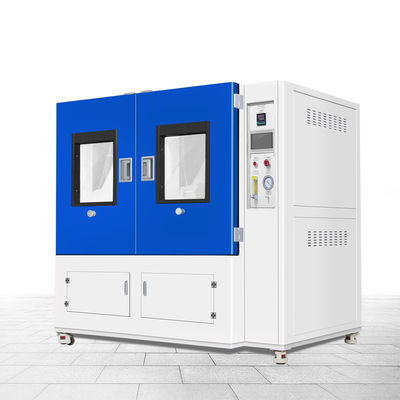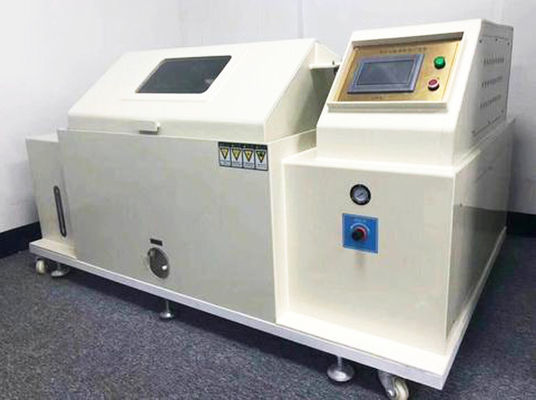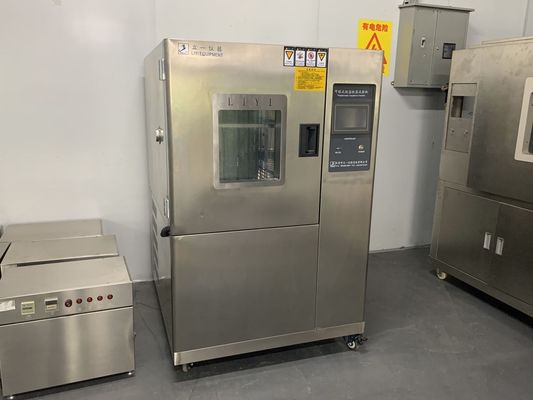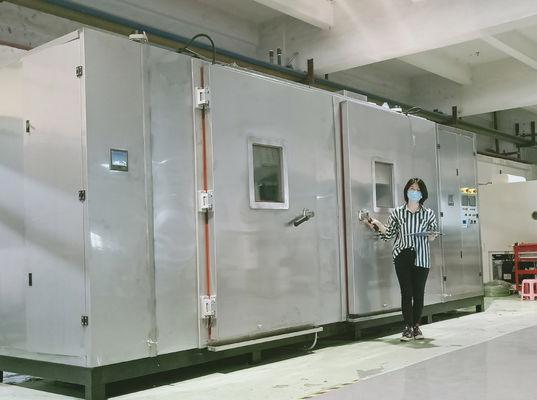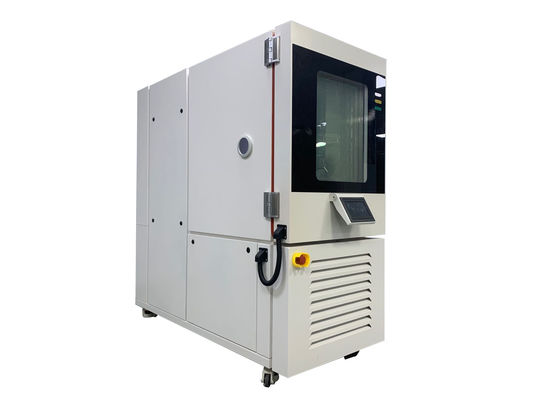
The low temperature control method of the high and low temperature damp heat test chamber: the refrigeration cycle adopts the reverse Carnot cycle, which consists of two isothermal processes and two adiabatic processes.
The process is as follows: after the refrigeration working fluid absorbs heat from the constant pressure gasification of the cold storage (at this time, the working fluid is usually dry saturated steam or close to dry saturated steam), and then enters the compressor for compression under adiabatic state, the temperature exceeds the ambient temperature, and then enters into condensation. The device dissipates isobarically to the ambient medium;
In the condenser, the superheated refrigerant vapor is first isobarically cooled to the saturation temperature corresponding to the current pressure, and then continues to be condensed isobarically (also isothermally) into a saturated liquid state, entering the throttle valve, and adiabatic throttle at the throttle valve. Flow cooling and depressurization to the wet saturated vapor state corresponding to the initial pressure of the cycle, and then enter the cold storage to gasify and absorb heat, complete the cycle, and conduct heat exchange with the surrounding medium to transfer heat to the surrounding medium
It is suitable for the inspection of various performance indicators of aerospace products, information electronic instruments, materials, electrical, electronic products, and various electronic components in high temperature, low temperature or humid and hot environments.

What is the role and significance of high and low temperature testing?
Degradable plastics exposed to heat can undergo various physical and chemical changes. Exposure time and temperature determine the degree and type of changes that occur. High temperature and short exposure periods are usually sufficient to shorten the induction period of oxidatively degradable plastics, a process that can lead to depletion of antioxidants and plasticizers. Physical properties such as tensile strength, impact strength, elongation, and modulus may induce changes during the induction period; however, these changes are usually not due to a decrease in molecular weight, but simply a response to temperature changes such as an increase in crystallinity Either a reduction in volatiles or both.
In general, short-term exposure of plastics to high temperatures releases volatile substances such as moisture, solvents, or plasticizers; reduces molding stress; enhances curing of thermosets; increases crystallinity; Both have color changes. Typically, progressive shrinkage will occur with a reduction in volatiles or with further polymerization. Certain plastics, such as PVC, may change due to loss of plasticizer or fracture surface of polymer molecular chains. Polypropylene and its copolymers tend to become very brittle as the molecules degrade, while polyethylene becomes soft before the tensile strength and elongation become low and brittle. Therefore, it is very necessary to study the performance of components and equipment such as plastics, rubbers, paints and varnishes, polymer materials, and circuit boards at high temperatures.
High and low temperature testing is a method used to determine the suitability of products for storage, transportation and use in high temperature climates. The severity of the test depends on the temperature of the elevated temperature and the duration of exposure. High and low temperature tests of polymer materials such as plastics, rubbers, paints and varnishes mainly include hot air aging, heat resistance test, determination of heat resistance, etc. Hot air accelerated aging means that the sample is exposed to a higher temperature than the environment in which the rubber is used, in order to obtain the effect of natural aging of the rubber in a short time. The heat resistance test refers to a test in which the sample is exposed to the same temperature change as the environment in which the rubber is used.
The main scope of high and low temperature testing includes electrical, electronic products, and their original components, and other materials. The severity of the test depends on the high and low temperature temperature and the duration of the test. High and low temperature may overheat the product, affect the safety and reliability of use, or even damage, such as:
· Bonding and migration between materials due to different expansion coefficients of various materials
· Change material properties
· Degrade the electrical performance of components The elasticity or mechanical strength of the elastic element is reduced, shortening the service life of the product
· Accelerate the deterioration and aging process of polymer materials and insulating materials, and shorten the service life of products.
· The elasticity of flexible materials such as rubber is reduced and cracks occur;
Increased brittleness of metals and plastics, leading to cracks or cracks;
Make materials brittle, such as plastics and steel, which are prone to brittle damage at low temperatures, and rubber materials increase in hardness and decrease in elasticity.

Operation details of high and low temperature damp heat laboratory
The high and low temperature humidity and heat laboratory adopts a balanced temperature and humidity adjustment method to obtain an accurate temperature and humidity environment. It has stable and balanced heating and humidifying performance, and can perform high-precision, high-temperature temperature and humidity control. Equipped with an intelligent temperature regulator, the temperature and humidity use a color LCD touch screen, and various complex program settings can be performed. The fixed value automatically selects the performance of the operating refrigeration circuit to achieve direct start-up refrigeration and direct cooling under high temperature conditions.
The base is made of channel steel welded into a mesh frame, so that it can bear the weight of the chamber body and the personnel specimen under horizontal conditions, without causing unevenness and cracking of the bottom surface of the chamber body. The chamber body is divided into six decent chambers and a double-opening or single-opening door. Anti-impact, the door material is also made of color steel plate, and the door handle is open inside and outside, so that the test personnel can freely open the door from the closed room.
The laboratory can record and trace the whole process of the test. Each motor is equipped with overcurrent protection/heater set short circuit protection, which ensures the high reliability of air volume and heating during equipment operation. It is equipped with USB interface and Ethernet communication function. , so that the communication and software expansion functions meet the various needs of customers. The popular cooling control mode is selected, which reduces energy consumption by 30% compared with the traditional heating balance temperature control mode, saving energy and electricity. The box is usually composed of an enclosure structure, an air duct system, a control system, and an indoor test structure.
In order to better ensure the regulation of the temperature reduction rate and temperature in the high and low temperature humidity and heat laboratory, the refrigeration unit adopts a cascade refrigeration unit composed of imported refrigeration compressors. convenience and other advantages.
When using, these details cannot be ignored. What are the specifics?
1. Strictly abide by the operating procedures of the system to prevent others from violating the operating system.
2. Non-technical personnel are not allowed to dismantle and repair the machine. If dismantling and repairing are required, the operation must be carried out under the condition of ensuring that the power is cut off and accompanied by personnel to avoid accidents.
3. When opening and closing the door or when taking the test object from the test box, do not let the test object come into contact with the rubber edge of the box door or the box edge to prevent the rubber edge from being worn.
4. The surrounding ground should be kept clean at all times to prevent a large amount of dust from being sucked into the unit to deteriorate the working conditions and reduce the performance.
5. Pay attention to protection during use, and not be hit by sharp or blunt objects. The test products placed in the test room should have a certain distance from the suction and exhaust ports of the air-conditioning channel, so as not to hinder the circulation of air.
6. Long-term shutdown will affect the effective service life of the system. Therefore, the system should be turned on at least once every 10 days. Do not make the system repeatedly in a short period of time. Once the operation is stopped, the number of starts per hour should be less than 5 times, and the time interval between each start-stop should not be less than 3 minutes. Do not open the door at low temperatures to prevent damage to the door seal.
7. After each test, set the temperature near the ambient temperature, work for about 30 minutes, then cut off the power supply and clean the inner wall of the work room.
8. Clean the evaporator (dehumidifier) regularly (every 3 months): due to the different cleanliness levels of the samples, under the action of forced air circulation, a lot of dust and other small particles will condense on the evaporator (dehumidifier), which should be carried out regularly. cleaning
9. The condenser should be regularly maintained and kept clean. The dust and sticky condenser will cause the compressor to dissipate poorly and cause the high-pressure switch to trip and cause false alarms. The condenser should be maintained regularly.
10. The humidifier should be cleaned regularly to avoid scale affecting the working efficiency and service life of the humidifier, as well as blockage of the water supply pipeline. When cleaning, disassemble the baffle of the studio evaporator, use a soft brush to scrub the humidifier, rinse it with clean water and drain it in time.
11. The wet bulb test cloth should be checked frequently. When the surface of the test cloth is not clean or hardened, it must be replaced, otherwise it will affect the accuracy of the humidity test by the control system. The test cloth is generally replaced once every three months. When replacing, clean the water head first, wipe the temperature measuring body with a cleaning cloth, and then replace the test cloth. When replacing the new test cloth, keep your hands clean.

 Your message must be between 20-3,000 characters!
Your message must be between 20-3,000 characters! Please check your E-mail!
Please check your E-mail!  Your message must be between 20-3,000 characters!
Your message must be between 20-3,000 characters! Please check your E-mail!
Please check your E-mail! 
